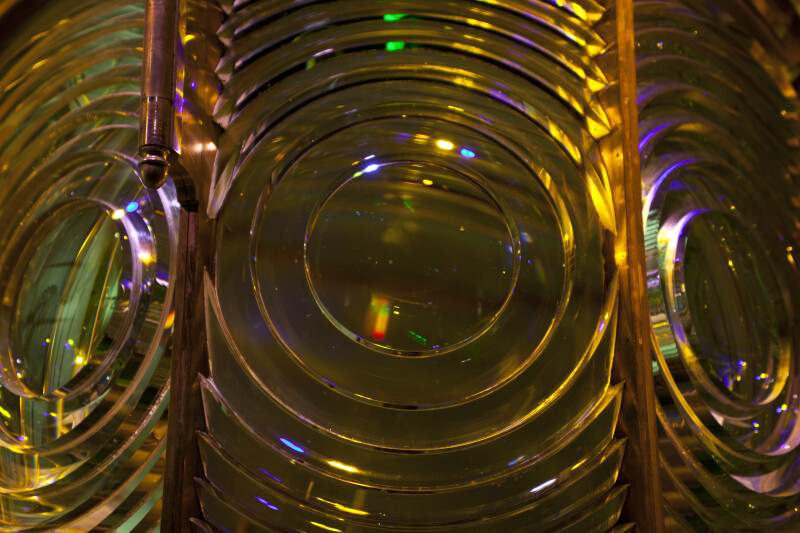
This beautiful glass object from the National Museum of American History in Washington, DC, is an example of an important optical invention that saved countless lives in the nineteenth and twentieth centuries. From its first use in a lighthouse in 1823 until it was replaced by more modern technology over a century later, Fresnel lenses enabled lighthouses to more effectively aim their beams across dangerous waters.
 Invented by Augustin-Jean Fresnel, Fresnel lens works by “collapsing” the thicker parts of a lens as shown in the diagram to the left. Notice that the curved parts of the glass that do the work of focusing the light are carefully preserved in the “flattened” Fresnel version. Glass is heavy. By greatly reducing the thickness of the lens, larger more powerful lights could be installed in lighthouses. Lighthouse lenses were constructed as tall as 12 feet (3.7 m) using the thinner Fresnel lenses.
Invented by Augustin-Jean Fresnel, Fresnel lens works by “collapsing” the thicker parts of a lens as shown in the diagram to the left. Notice that the curved parts of the glass that do the work of focusing the light are carefully preserved in the “flattened” Fresnel version. Glass is heavy. By greatly reducing the thickness of the lens, larger more powerful lights could be installed in lighthouses. Lighthouse lenses were constructed as tall as 12 feet (3.7 m) using the thinner Fresnel lenses.
Nowadays, extremely thin Fresnel lenses can be manufactured using clear plastic. The magnifying sheets you may find in a dollar store are actually very, very flat Fresnel lenses. If you look closely, you can see the concentric circles stamped into the plastic.
Now that you understand how a Fresnel lens works, explore the gallery of lens drawings below. Many of the illustrations are taken from patent applications. They were among the most important inventions in the 1800s.
Lenses and Refraction
These are just a few of the dozens of lens illustrations on the ClipArt ETC website. The illustrations show the refraction of light through glass, the many types of lenses, and of course, numerous examples of Fresnel lenses.
Roy Winkelman is a 40+ year veteran teacher of students from every level kindergarten through graduate school. As the former Director of FCIT, he began the Center's focus on providing students with rich content collections from which to build their understanding. When not glued to his keyboard, Dr. Winkelman can usually be found puttering around his tomato garden in Pittsburgh. Questions about this post or suggestions for a future topic? Email me at winkelma@usf.edu. To ensure that your email is not blocked, please do not change the subject line. Thank you!
FCIT Newsletter
Each month FCIT publishes a newsletter with short articles on teaching and learning with technology, using digital content in the classroom, and technology integration. Subscribe today! The subscription form will open in a new window. When you have subscribed, you can close the new window to return to this page.

